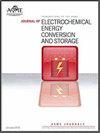Lithium-ion battery capacity prediction method based on improved extreme learning machine
IF 2.7
4区 工程技术
Q3 ELECTROCHEMISTRY
Journal of Electrochemical Energy Conversion and Storage
Pub Date : 2024-03-18
DOI:10.1115/1.4065095
引用次数: 0
Abstract
Currently, research and applications in the field of capacity prediction mainly focus on the use and recycling of batteries, encompassing topics such as SOH estimation, RUL prediction, and echelon use. However, there is scant research and application based on capacity prediction in the battery manufacturing process. Measuring capacity in the grading process is an important step in battery production. The traditional capacity acquisition method consumes considerable time and energy. To address the above issues, this study establishes an improved extreme learning machine (ELM) model for predicting battery capacity in the manufacturing process, which can save approximately 45% of energy and time in the grading process. The study involves the extraction of features from the battery charge–discharge curve that can reflect battery capacity performance and subsequent calculation of the grey correlation between these features and capacity. The feature set comprises features with a high correlation with capacity, which are used as inputs for the ELM model. Kernel functions are used to adjust the ELM model, and Bayesian optimization methods are employed to automatically optimize the hyperparameters to improve the capacity prediction performance of the model. The study uses lithium-ion battery data from an actual manufacturing process to test the predictive effect of the model. The mean absolute percentage error of the capacity prediction results is less than 0.2%, and the root-mean-square error is less than 0.3 Ah.基于改进型极端学习机的锂离子电池容量预测方法
目前,容量预测领域的研究和应用主要集中在电池的使用和回收方面,包括 SOH 估算、RUL 预测和梯次使用等主题。然而,基于电池制造过程中容量预测的研究和应用却很少。分级过程中的容量测量是电池生产的重要步骤。传统的容量获取方法耗费大量时间和精力。针对上述问题,本研究建立了一个改进的极端学习机(ELM)模型,用于预测生产过程中的电池容量,可在分级过程中节省约 45% 的精力和时间。研究包括从电池充放电曲线中提取能反映电池容量性能的特征,然后计算这些特征与容量之间的灰色关联度。特征集包括与容量高度相关的特征,这些特征被用作 ELM 模型的输入。使用核函数调整 ELM 模型,并采用贝叶斯优化方法自动优化超参数,以提高模型的容量预测性能。研究使用实际制造过程中的锂离子电池数据来测试模型的预测效果。容量预测结果的平均绝对百分比误差小于 0.2%,均方根误差小于 0.3 Ah。
本文章由计算机程序翻译,如有差异,请以英文原文为准。
求助全文
约1分钟内获得全文
求助全文
来源期刊

Journal of Electrochemical Energy Conversion and Storage
Engineering-Mechanics of Materials
CiteScore
4.90
自引率
4.00%
发文量
69
期刊介绍:
The Journal of Electrochemical Energy Conversion and Storage focuses on processes, components, devices and systems that store and convert electrical and chemical energy. This journal publishes peer-reviewed archival scholarly articles, research papers, technical briefs, review articles, perspective articles, and special volumes. Specific areas of interest include electrochemical engineering, electrocatalysis, novel materials, analysis and design of components, devices, and systems, balance of plant, novel numerical and analytical simulations, advanced materials characterization, innovative material synthesis and manufacturing methods, thermal management, reliability, durability, and damage tolerance.
 求助内容:
求助内容: 应助结果提醒方式:
应助结果提醒方式:


